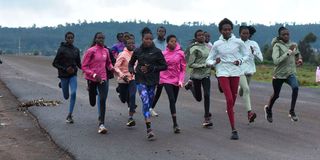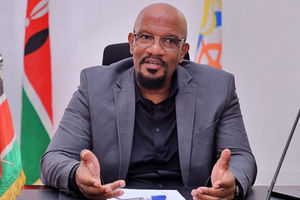
Nala Track Club in Nyahururu. The high altitude area has favourable weather conditions ideal for athletes to train, but encroachment into the forest over the years has resulted in the shrinking of the forest.
Kenya's long-distance running prowess has been scientifically proven to be a winning combination of the Rift Valley's high-altitude climate and a sprint of genetic advantage.
But this winning combination is under serious threat from the effects of climate change, as the famous forested high-altitude training areas take a beating from human activity.
The climate change conversation is gaining momentum in Kenya, which early last year hosted the inaugural Africa Climate Summit, a continental discussion on changing weather patterns.
Clearly, science has shown that climate change affects most aspects of our lives, with food security and health being the most common.

Olympic marathon champion Peres Jepchirchir during an interview about climate change and sport at her home in Kapsabet, Nandi County, on November 21, 2023.
Another emerging trend that seems to have been forgotten is that climate change is hitting the world of sport hard, threatening the country's naturally rich athletics training areas.
Many regions around the world, including those known for their natural advantage in sports training due to high altitude, forests or specific climatic conditions, are experiencing changes that can affect training grounds and athletic performance.
Shifts in weather patterns, including changes in precipitation, temperature, and humidity, can significantly impact training conditions.
For instance, alterations in rainfall patterns might affect the availability of water for athletes or alter the quality of playing surfaces.
Increasing temperatures can make it more challenging for athletes to train effectively, especially in sports that require cool conditions. Higher temperatures might also lead to heat-related health risks during training sessions or competitions.
Deforestation and changes in ecosystems due to climate change can lead to the loss of training areas.
Forested areas that were once ideal for certain types of athletic training might be threatened by deforestation or altered due to changing environmental conditions.

Mary Ekiru of Nala Track Club in Nyahururu, Naikipia County, who runs the 1,500m race, during an interview after training on the outskirts of Nyahururu town on November 24, 2023.
According to the third annual survey conducted by World Athletics to gauge the attitudes of elite athletes about environmental and social issues, three-quarters of the athletes perceive a direct negative impact on their health and performance due to climate change with 85 per cent expressing that the sport of athletics has experienced adverse consequences.
Nation.africa has been profiling the most preferred athletics training areas in the country and while on a fact-finding mission, we can authoritatively report that the country’s athletics prowess is being threatened by the effects of climate change.
Kenya has always been the preferred destination for distance running training, but areas like Nyahururu in Laikipia County, Iten (Elgeyo Marakwet County), and Kapsabet (Nandi County), among others, have seen the rise in temperatures compared to previous years.
Iten has always played host to thousands of aspiring, elite, retired and foreign athletes earning the town the name “Home of Champions.”
Besides its credible high altitude regions that tower between 2,300 metres to over 3,000 metres above sea level, the rich forest cover makes the county conducive for high-performance athletics training.
On the other note, human activities have encroached and shaved off sections of forested areas exposing the high altitude areas to climate change something that former three-time 3,000 metres steeplechase world champion Moses Kiptanui confirms.
Despite his transition to a business career, Kiptanui remains connected to his village and he occasionally visits armed with tree seedlings that he distributes to the community and he uses these visits as opportunities to advocate for environmental conservation, citing himself as a beneficiary of such practices.

A view of the Kapsait Trading Centre in Elgeyo Marakwet County. Athletes such as former world marathon record holder Brigid Kosgei and others train in the area.
Reflecting on his past, Kiptanui recalls Kerera Forest, once a dense and vital environment where he commenced his athletics journey and he notes with concern the substantial human encroachment and destruction that has significantly altered the landscape.
The Kapcherop Conservancy, where Kerera Forest is located, has witnessed a decline in its once-thriving ecosystem due to these human-induced impacts.
Kiptanui's efforts in supplying tree seedlings and raising awareness about the importance of environmental preservation highlight his commitment to restoring and safeguarding the natural habitat that once supported his career.
His advocacy serves as a reminder of the need for communities to actively participate in conserving their environment for the benefit of present and future generations, something he said that if that continues, the future generation will suffer the brunt.
Kiptanui took the nation.africa team on a forest tour and it was evident that human encroachment was real, and this is where we witnessed the felling of huge trees and burning of charcoal.
“We have a problem here because if we continue cutting trees, then we have to forget about clean air and the climate change mitigations will catch up with us. The whole world is now focused on making sure we have a common discussion of conservation and that is the only way to go so that we can have something for our future generations,” said Kiptanui.
Kiptanui vividly remembers the early days of his training in the area, characterised by a dense forest cover that created an environment where the trails were shrouded in thick foliage.
Recalling those times, he mentions that the density of the forest canopy was such that it made it challenging to even catch a glimpse of the sun while running through those trails.
“Climate change is real and if you were here in the 1970s and 1980s, when we grew up, there’s a lot of difference because we used to have many wild animals but they are no longer there because of global warming.

Moses Kiptanui. The forest, which is in a high altitude area where several athletes train to perform well in various races around the world, is under threat due to unchecked logging, raising concerns about the clean air needed during training.
During those days, we used to wear heavy clothes but nowadays, we walk with just a T-shirt on, which means the temperatures have really risen, and this is only in 30 years. What will happen in the next 50 or 100 years to come?’’ he poses.
During the conversation, the athletics star walks us through the forest and the deeper we get inside, the more we realise that the forest could possibly be a shell of its former self.
We come across hundreds of tree stumps an indication of a depleting forest that was once a tower of high altitude region.
For your information, Kapsait Athletics Training Camp, which is at the border of Elgeyo Marakwet County and West Pokot County, is within the region and it shot to the limelight after Brigid Kosgei broke the world marathon record in 2019 when she clocked two hours, 14 minutes and four seconds before the record was lowered by Ethiopia’s Tigst Assefa who clocked 2:11:43.
Also read: Kaya elders embark on restoration of degraded sacred forests
During our tour, the hunt for aged indigenous trees takes a while and to our reprieve, we come across a massive towering tree whose circumference requires about six adults to hold hands around it.
The most accurate way foresters determine the age of a tree is by counting its growth rings and the team which was accompanied by the locals estimated the age of the tree as more than 100 years of growth.
The situation in Nyahururu is reflective of a broader issue seen in many regions worldwide—human encroachment and unsustainable development leading to the degradation of natural habitats and training areas.
High-altitude regions like Nyahururu have been historically prized for their favourable training conditions for athletes due to factors like thinner air, which can help improve endurance and performance.
However, human encroachment, deforestation, and urbanisation are threatening these areas.
The clearing of forests and construction of buildings not only reduces the available training space for athletes but also disrupts local ecosystems, potentially leading to a loss of biodiversity and further environmental degradation.
Additionally, urbanisation often brings with it increased pollution, changes in microclimates, and alterations in natural water systems, all of which can impact the training environment and the overall well-being of the area.
Nyahururu, with its high altitude and favourable training conditions, indeed served as a popular destination for Team Kenya's athletic training and preparation for global events from the 1960s to the 1990s.
The region's high altitude, cooler temperatures, and other environmental factors made it an ideal location for athletes to acclimate and train, especially for endurance events.
However, the landscape and environment in Nyahururu have changed over the years due to human encroachment, deforestation, and urbanisation.
These alterations may have affected the suitability of the area for training purposes, potentially leading to the decline in Nyahururu's status as a preferred training destination for Team Kenya and other athletes preparing for global competitions.
Kenya’s athletics legend and one of the pioneers of sports the 83-year-old, Kipchoge Keino, even in his retirement years lives by athletics as the proprietor of High Performance Training Centre in Eldoret, Uasin Gishu County.

Moses Kiptanui has taken the initiative to mobilise locals to stop further logging as authorities turn a blind eye to the destruction.
Kipchoge, in an interview with nation.africa, said he has seen the effects of climate change in the country, but he quickly says that Kenya has the best climate of all the 187 countries he has travelled to since he started his running career.
“Good climate in sports is important because what you take in as an athlete or even footballer is critical in your performance. If you take an athlete from the coast to a high altitude area, he or she will definitely produce better results due to good conditions,” said Kipchoge.
Kipchoge said that during his active days in athletics, he preferred training in Uasin Gishu owing to its good air quality, adding the region had a good environment and the forest cover was good.
Devoid of industrialisation and human activities, the top air quality was one of the best-kept secrets while making the country proud in podium finishes in the 1,500m race, 3,000m steeplechase race and 5,000m race.
He managed to bag a gold medal in 1,500m just like his compatriots the late Naftali Temu (10,000m) and Amos Biwott (3,000m steeplechase).
“During those days, we had a very good environment because there were very few industries and the air was fresh and that made me perform well during my training and various international races that I managed to compete in,” added Kipchoge.
He added that before the era of climate change in the country which has now been witnessed, he managed to train in various high-altitude regions and he said that the areas had moderate temperatures good for training.
“My best training areas were Kiganjo in Nyeri County and Nyahururu where team Kenya used to camp ahead of Commonwealth Games, World Championships or Olympic Games and we did well because of the right training conditions.
“If you go to Nyahururu now, there is an increase of population and the good climate conditions that athletes used to enjoy is decreasing and there is a need to intervene and conserve these areas,” he said at his Kazi Mingi fram in Eldoret, Uasin Gishu County.
Kipchoge tells of his fears that if the effects of climate change on sportsmanship in the country are not addressed, then the Kenyan prowess in athletics is endangered.
He advised the identification, conservation and government protection of athletics training areas in the country just to preserve the ecosystems that support Kenyan athletes in training.
“As a country we just have to change and the whole community in conjunction with the national government needs to mobilise and make sure there is an increase in forest cover,” said the legend.
Nyahururu is one of the major townships which boasts of being among the best sports training grounds in the country and has produced some of the best in the world.
The most notable name is the late Samuel Wanjiru, who was the first Kenyan to win an Olympic marathon gold medal during the 2008 Beijing Olympic Games.
And apart from Kiptanui and Kipchoge, Charles Kamathi, the last man to win a gold medal in 10,000m in a World Championship in 2003 during the 2001 Edmonton games, is a beneficiary of good quality training.
But all is not lost as upcoming junior athletes are taking any slight advantage to train and make sure they get the right skills to battle it out with other international athletes.
Nara Camp in Nyahururu supports young girls, an initiative that was launched by former World Half Marathon Championships bronze medalist Mary Ngugi.
We caught up with the group after their training and their coach Lilian said that the population has increased and the forest cover is decreasing though people have started realising the need to plant trees.
“We only have one forest area remaining in this region, unlike my days when I was training. I had choices on which forest to train in and this is due to the population increase which has seen people clear trees and that also contributes to high temperatures because we have only Bioman Forest,” said Lilian.
In the second part of this Special Series, we will feature the campaigns by Athletics Kenya, Stockholm Environment Institute and the United Nations Environmental Programme on climate action.







